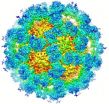(Press-News.org) Scientists at USC and Lawrence Berkeley National Lab have discovered a new route by which a proton (a hydrogen atom that lost its electron) can move from one molecule to another – a basic component of countless chemical and biological reactions.
"This is a radically new way by which proton transfer may occur," said Anna Krylov, professor of chemistry at the USC Dornsife College of Letters, Arts and Sciences. Krylov is a co-corresponding author of a paper on the new process that was published online by Nature Chemistry on March 18.
Krylov and her colleagues demonstrated that protons are not obligated to travel along hydrogen bonds, as previously believed. The finding suggests that protons may move efficiently in stacked systems of molecules, which are common in plant biomass, membranes, DNA and elsewhere.
Armed with the new knowledge, scientists may be able to better understand chemical reactions involving catalysts, how biomass (plant material) can be used as a renewable fuel source, how melanin (which causes skin pigmentation) protects our bodies from the sun's rays, and damage to DNA.
"By better understanding how these processes operate at molecular level, scientists will be able to design new catalysts, better fuels, and more efficient drugs," Krylov said.
Hydrogen atoms are often shared between two molecules, forming a so-called hydrogen bond. This bond determines structures and properties of everything from liquid water to the DNA double helix and proteins.
Hydrogen bonds also serve as pathways by which protons may travel from one molecule to another, like a road between two houses. But what happens if there's no road?
To find out, Krylov and fellow corresponding author Ahmed Musahid of the Lawrence Berkeley National Lab created a system in which two molecules were stacked on top of each other, without hydrogen bonds between them. Then they ionized one of the molecules to coax a proton to move from one place to another.
Ahmed and Krylov discovered that when there's no straight road between the two houses, the houses (molecules) can rearrange themselves so that their front doors are close together. In that way, the proton can travel from one to the other with no hydrogen bond – and with little energy. Then the molecules return to their original positions.
"We've come up with the picture of a new process," Krylov said.
###
This research was performed under the auspices of the iOpenShell Center and supported by the US Department of Energy, the Defense Threat Reduction Agency, and the National Science Foundation.
Scientists discover new method of proton transfer
In a paradigm shift in the understanding of chemical reactions, a team from USC and Lawrence Berkeley National Lab finds that protons do not have to move along hydrogen bonds after all
2012-03-22
ELSE PRESS RELEASES FROM THIS DATE:
Emerge Medical Awarded an Orthopedic Trauma Agreement with the Premier Healthcare Alliance
2012-03-22
Emerge Medical, Inc., a pioneer in generic orthopedic devices for the healthcare industry, recently announced that it has signed a nationwide agreement with the Premier healthcare alliance. The agreement will make Emerge's orthopedic devices available to Premier's 2,500 hospital members at specially negotiated pricing and terms.
Emerge will provide Premier member hospitals with a high-quality, low-cost alternative to traditional medical device suppliers. Emerge manufactures standard orthopedic devices exclusively in the United States and provides them for 40 to 50% ...
Discovery offers insight into treating viral stomach flu
2012-03-22
ST. LOUIS, MO, March 21, 2012—Twenty million Americans get sick from norovirus each year according to data released last week by the Centers for Disease Control (CDC). Often called vomiting illness, it can spread rapidly on cruise ships, and in dormitories and hospitals. Recent data from the CDC shows deaths from gastrointestinal infections have more than doubled and have become a particular threat to the elderly. The virus is shed in the stool of the infected individual, has a short incubation period and can spread quickly if proper hand washing and other measures ...
UF researchers look for ways to make an emerging technology safe for environment
2012-03-22
GAINESVILLE, Fla. — The percentage of electronic waste occupying our landfills has grown at an alarming rate over the last decade, giving rise to concerns about the toxicity of components used in consumer electronics.
Researchers at the University of Florida are looking for ways to minimize environmental hazards associated with a material likely to play an increasingly important role in the manufacture of these goods in the future. The results of their most recent studies are published in the March 2012 issue of Nanotoxicology.
Carbon nanotubes are already being used ...
Genetic mutation found in familial chronic diarrhea syndrome
2012-03-22
HUNTSVILLE, Ala. -- When the intestines are not able to properly process our diet, a variety of disorders can develop, with chronic diarrhea as a common symptom. Chronic diarrhea can also be inherited, most commonly through conditions with genetic components such as irritable bowel syndrome. Researchers in Norway, India, and at the HudsonAlpha Institute for Biotechnology have identified one heritable DNA mutation that leads to chronic diarrhea and bowel inflammation.
Shawn Levy, Ph.D., faculty investigator at HudsonAlpha said, "Based on the effects seen from this one ...
Middle school teacher support lowers risk for early alcohol use
2012-03-22
SEATTLE – March 21, 2012: Anxiety, depression, stress and social support can predict early alcohol and illicit drug use in youth, according to a study from Carolyn McCarty, PhD, of Seattle Children's Research Institute, and researchers from the University of Washington and Seattle University. Middle school students from the sixth to the eighth grade who felt more emotional support from teachers reported a delay in alcohol and other illicit substance initiation. Those who reported higher levels of separation anxiety from their parents were also at decreased risk for early ...
Monarch butterflies down again this year as decline continues, says Texas A&M expert
2012-03-22
COLLEGE STATION, March 21, 2012 – Unlike their colorful wings, the future of Monarch butterflies may not be too bright and their numbers are expected to be alarmingly down again this year, says a Texas A&M University researcher.
Craig Wilson, a senior research associate in the Center for Mathematics and Science Education and a long-time butterfly enthusiast, says reports by the World Wildlife Fund, private donors and Mexico's Michoacan state show that Monarch numbers will be down almost 30 percent in 2012 as they make their annual trek from their breeding grounds in ...
International Logistics Solutions, an Offshore Group Company, Becomes Certified C-TPAT Trade Partner
2012-03-22
International Logistics Solutions (ILS) has recently been certified as a partner in The Customs-Trade Partnership against Terrorism (C-TPAT) program.
By participating in this important Customs and Border Protection Agency initiative, ILS will be making a vital contribution towards helping to secure the nation's borders, as well as ensuring the continued flow of international free trade.
As a C-TPAT partner, the role of International Logistics Solutions (ILS) is to make certain that appropriate security measures, based upon risk analysis and consistent with C-TPAT ...
Low socioeconomic status means worse health -- but not for everyone
2012-03-22
Poverty is bad for your health. Poor people are much more likely to have heart disease, stroke, and cancer than wealthy people, and have a lower life expectancy, too. Children who grow up poor are more likely to have health problems as adults.
But despite these depressing statistics, many children who grow up poor have good health. In a new article published in Perspectives on Psychological Science, a journal of the Association for Psychological Science, Edith Chen and Gregory E. Miller of the University of British Columbia suggest a possible reason: some children have ...
Parents of children with cancer distrust and fear online sources of health information, study shows
2012-03-22
BUFFALO, N.Y. -- Parents and adult caregivers of pediatric cancer patients prefer personal consultations with trusted health care providers over online sources for information about their child's illness, according to a University at Buffalo research study.
Despite the accessibility of online medical information, the UB study found that parents not only distrusted information found through the Internet, they often feared what types of information they might encounter.
"Respondents were telling us they were uncertain of the information online and that they were afraid ...
False killer whales use acoustic squint to target prey
2012-03-22
Hunting in the ocean's murky depths, vision is of little use, so toothed whales and dolphins (odontocetes) rely on echolocation to locate tasty morsels with incredible precision. Laura Kloepper from the University of Hawaii, USA, explains that odontocetes produce their distinctive echolocation clicks in nasal structures in the forehead and broadcast them through a fat-filled acoustic lens, called the melon. 'Studies by other people showed odontocetes have the ability to control the shape of the echolocation beam and it has always been assumed that they are using the melon ...
LAST 30 PRESS RELEASES:
Tracing the quick synthesis of an industrially important catalyst
New software sheds light on cancer’s hidden genetic networks
UT Health San Antonio awarded $3 million in CPRIT grants to bolster cancer research and prevention efforts in South Texas
Third symposium spotlights global challenge of new contaminants in China’s fight against pollution
From straw to soil harmony: International team reveals how biochar supercharges carbon-smart farming
Myeloma: How AI is redrawing the map of cancer care
Manhattan E. Charurat, Ph.D., MHS invested as the Homer and Martha Gudelsky Distinguished Professor in Medicine at the University of Maryland School of Medicine
Insilico Medicine’s Pharma.AI Q4 Winter Launch Recap: Revolutionizing drug discovery with cutting-edge AI innovations, accelerating the path to pharmaceutical superintelligence
Nanoplastics have diet-dependent impacts on digestive system health
Brain neuron death occurs throughout life and increases with age, a natural human protein drug may halt neuron death in Alzheimer’s disease
SPIE and CLP announce the recipients of the 2025 Advanced Photonics Young Innovator Award
Lessons from the Caldor Fire’s Christmas Valley ‘Miracle’
Ant societies rose by trading individual protection for collective power
Research reveals how ancient viral DNA shapes early embryonic development
A molecular gatekeeper that controls protein synthesis
New ‘cloaking device’ concept to shield sensitive tech from magnetic fields
Researchers show impact of mountain building and climate change on alpine biodiversity
Study models the transition from Neanderthals to modern humans in Europe
University of Phoenix College of Doctoral Studies releases white paper on AI-driven skilling to reduce burnout and restore worker autonomy
AIs fail at the game of visual “telephone”
The levers for a sustainable food system
Potential changes in US homelessness by ending federal support for housing first programs
Vulnerability of large language models to prompt injection when providing medical advice
Researchers develop new system for high-energy-density, long-life, multi-electron transfer bromine-based flow batteries
Ending federal support for housing first programs could increase U.S. homelessness by 5% in one year, new JAMA study finds
New research uncovers molecular ‘safety switch’ shielding cancers from immune attack
Bacteria resisting viral infection can still sink carbon to ocean floor
Younger biological age may increase depression risk in older women during COVID-19
Bharat Innovates 2026 National Basecamp Showcases India’s Most Promising Deep-Tech Ventures
Here’s what determines whether your income level rises or falls
[Press-News.org] Scientists discover new method of proton transferIn a paradigm shift in the understanding of chemical reactions, a team from USC and Lawrence Berkeley National Lab finds that protons do not have to move along hydrogen bonds after all


